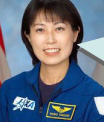|
|||||
| << January | March >> |
This is JAXA's Japanese astronaut primary activity report for February 2006.
 |
| Astronaut Yamazaki during training (front) |
For two weeks, Astronaut Yamazaki received training on the Canadarm 2 at the Canadian Space Agency (CSA).
This is the same type of training given to the ISS Expedition crew members and the astronauts who operate the Canadarm 2 during ISS assembly missions, to operate the Canadarm 2 and the Mobile Base System (MBS). Astronaut Yamazaki received both lectures and simulator training on the use of the Canadarm 2: for grasping a payload using the Canadarm 2 and for responding to anomalies while grasping payloads.
 |
This was the first training that I received at the CSA since November 2000, when I received robotics training as part of my ISS Astronaut candidate basic training. The training in Montreal was truly meaningful, taking place with experienced instructors, in a culturally rich city where a heritage of both English and French-speaking people coexists. I am really looking forward to operating both the Canadarm 2 and the Japanese Experiment Module Remote-Manipulator System (JEMRMS) of the Japanese Experiment Module "Kibo". |
 |
 |
| Astronaut Wakata building a shelter | NOLS participants |
Astronaut Wakata participated in the National Outdoor Leadership School (NOLS) in the mountains of Wyoming, along with ISS crew candidates and NOLS instructors. For two weeks, the participants lived as a group in an environment with limited amounts of clothing, food, and tools, similar to conditions experienced during a spaceflight. This training focused on developing leadership by taking turns in being the leader each day, and by learning to work together as a team. These are the same type of skills that will be required during an actual spaceflight.
The training took place in snowy mountains with temperatures ranging from -7°C to -29°C. The participants carried their own backpacks, pulled sleds, and wore cross-country skis while moving around in the mountains. Through outdoor activities, such as building shelters at the camp and searching for supplies that were buried in the mountains, the members learned the skills required both to lead a team and to work together as a team.
 |
| Astronaut Hoshide participating in the simulation |
Astronaut Hoshide participated in the simulated operations of Kibo at the Tsukuba Space Center (TKSC). The Kibo simulator was used to simulate orbital operations of Kibo.
In addition to the regular Kibo operations, we simulated the activation of Japan's newly developed Cell Biology Experiment Facility (CBEF) and Image-Processing Unit (IPU). Astronaut Hoshide served as the CAPCOM between the astronauts and mission control. When anomalies in Kibo were simulated, possible measures to resolve the anomalies were discussed and operations were rescheduled.
 |
| Astronaut Furukawa receiving JEMRMS training |
As part of his Kibo system-operations training, Astronaut Furukawa received training on operating the JEMRMS, Kibo's robotic arm. Astronaut Furukawa had previously received JEMRMS operations training. To brush up on his skills, he participated in the operations training, using a simulator under the guidance of an instructor.
| << January | March >> |

|